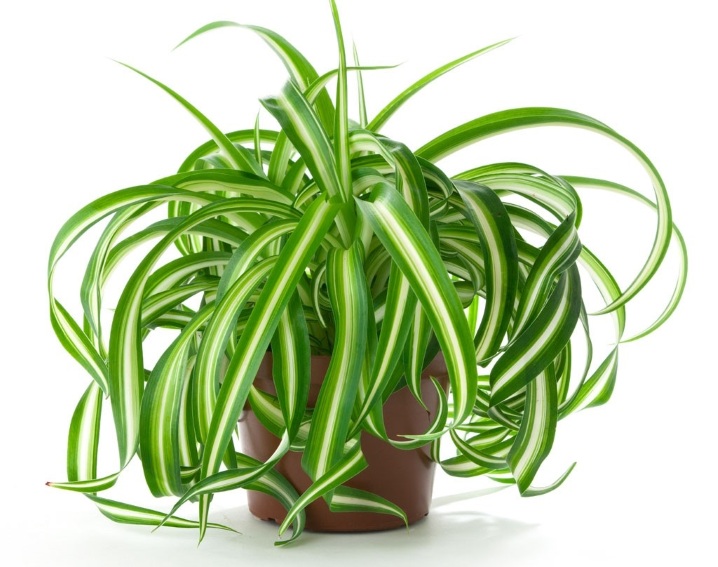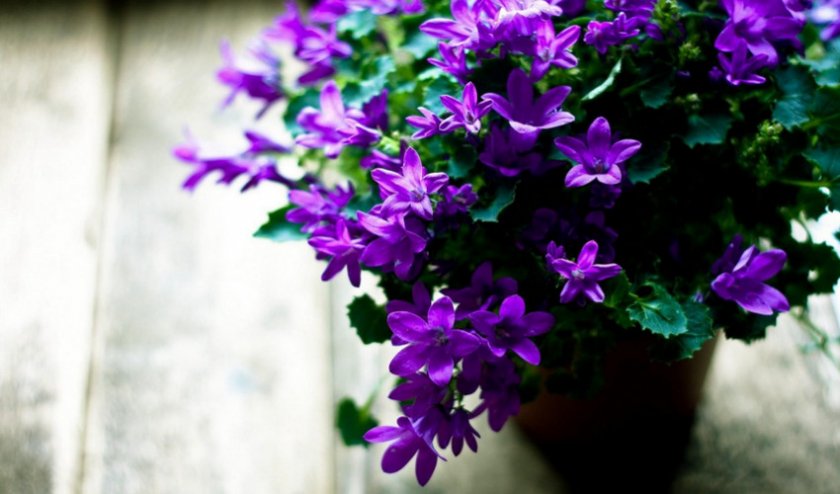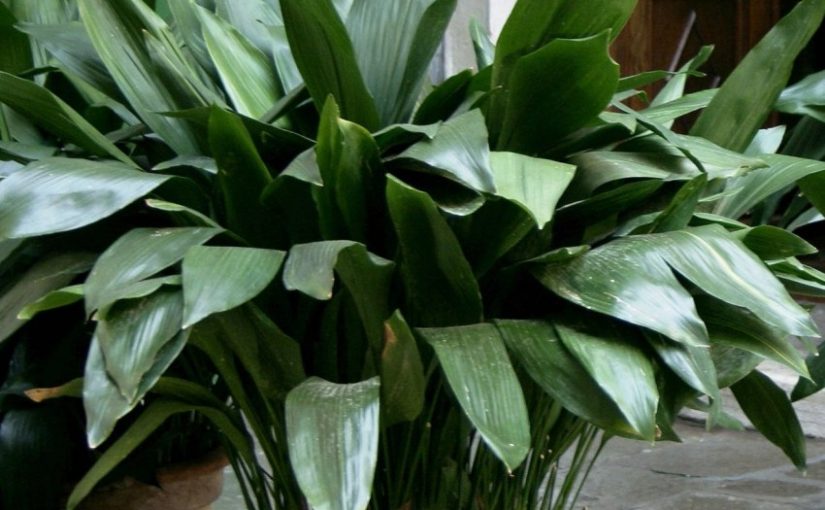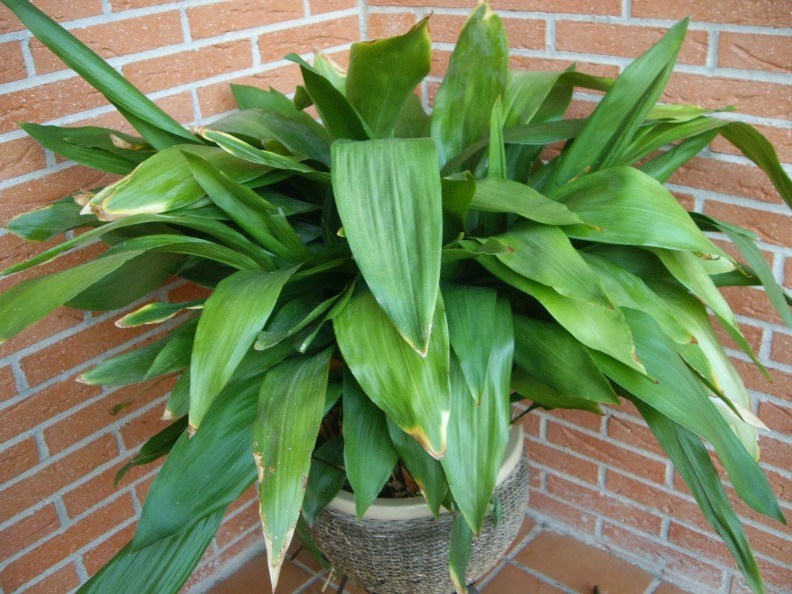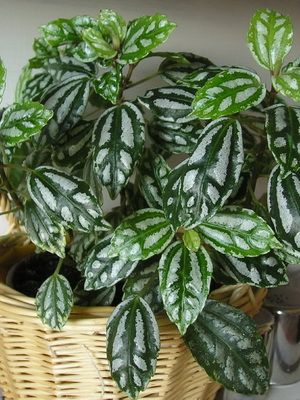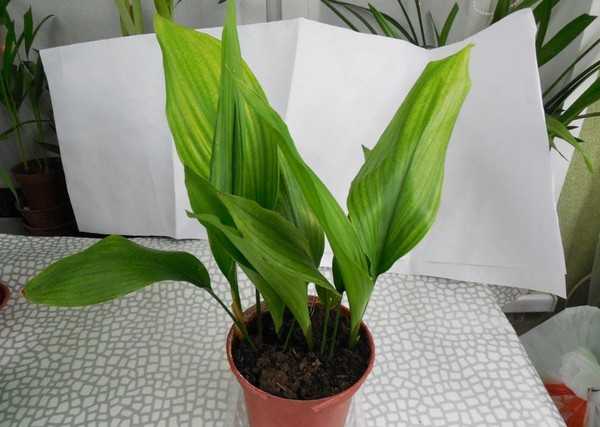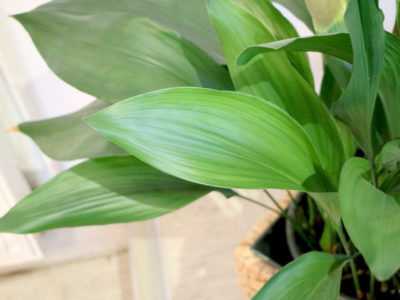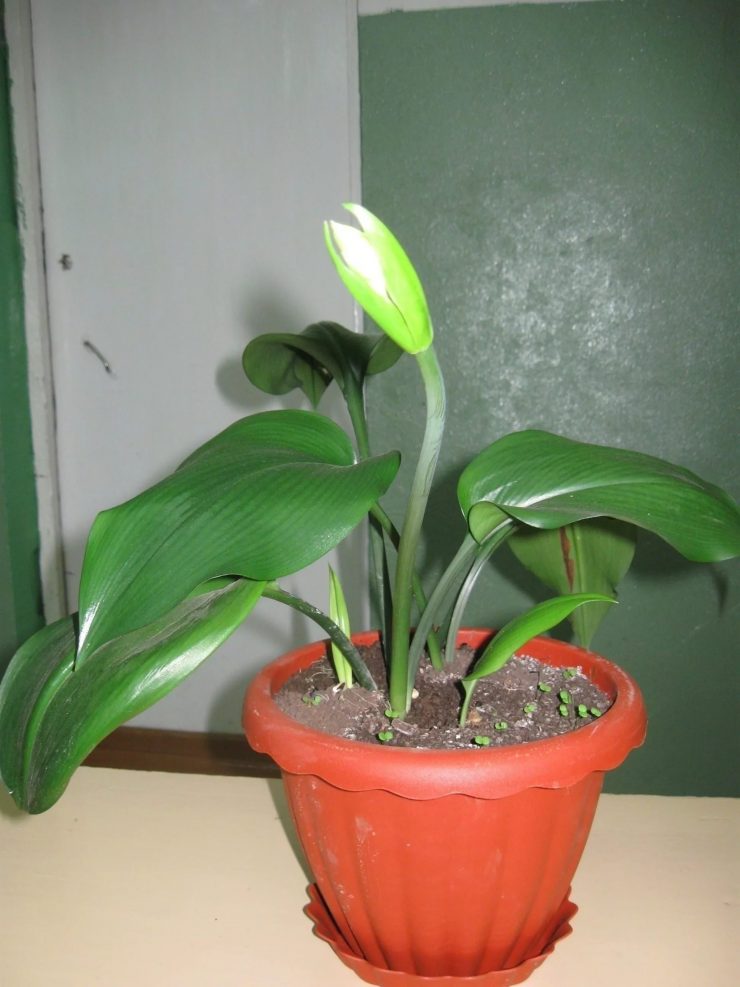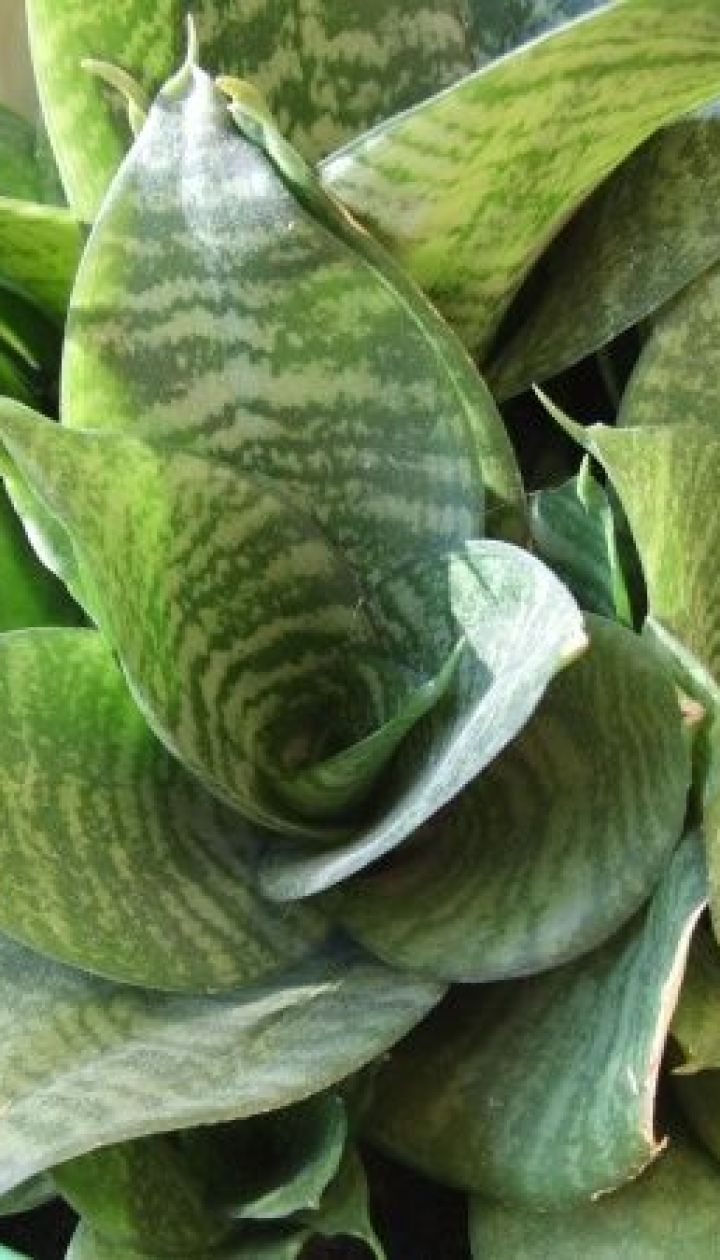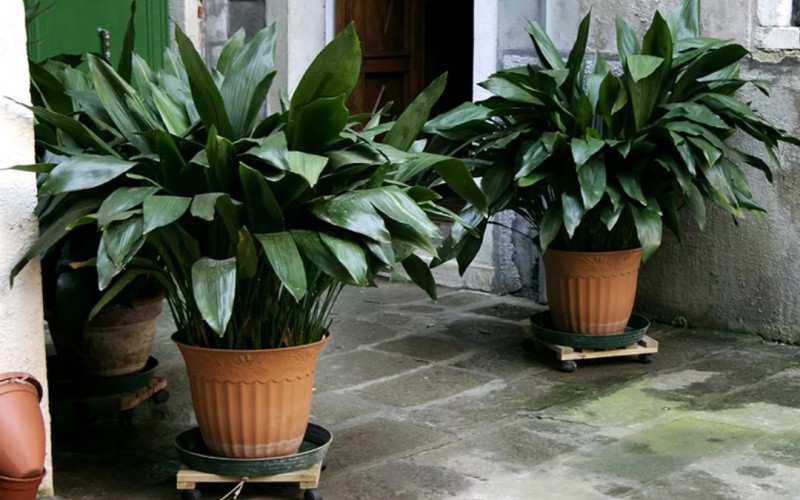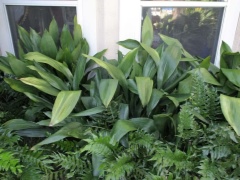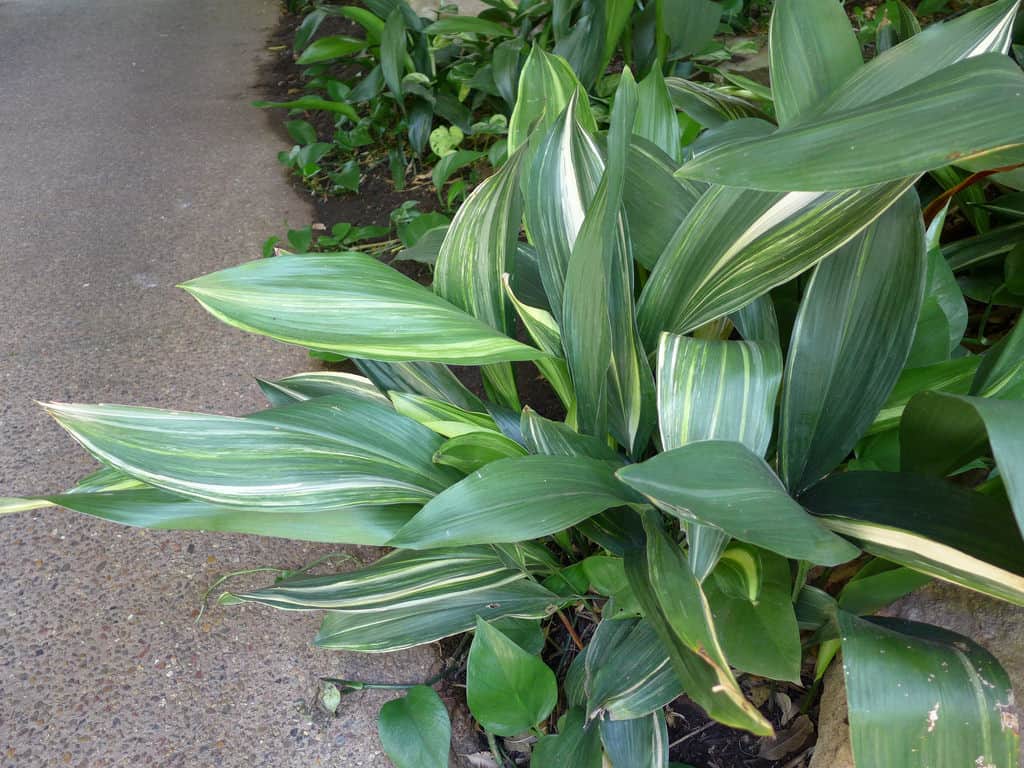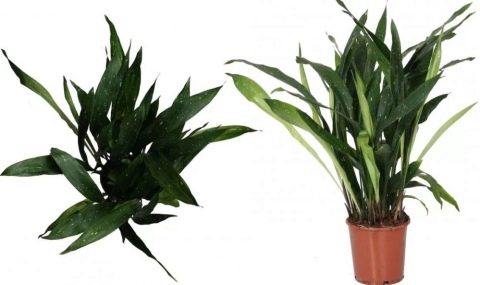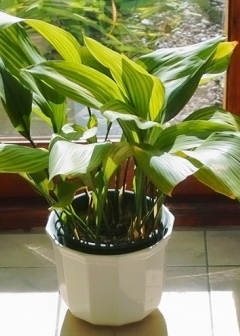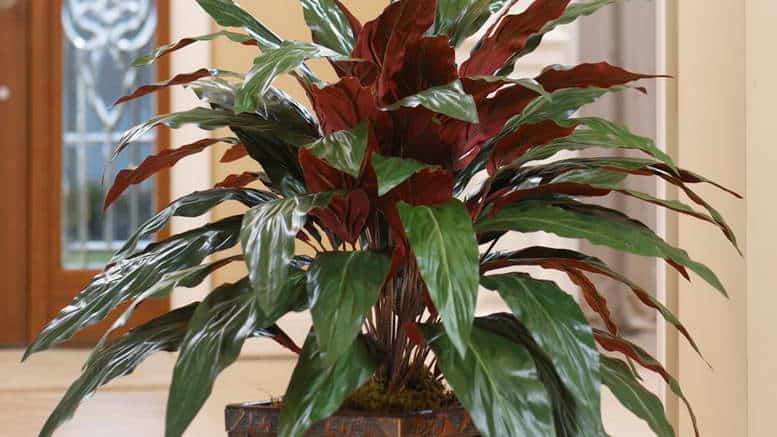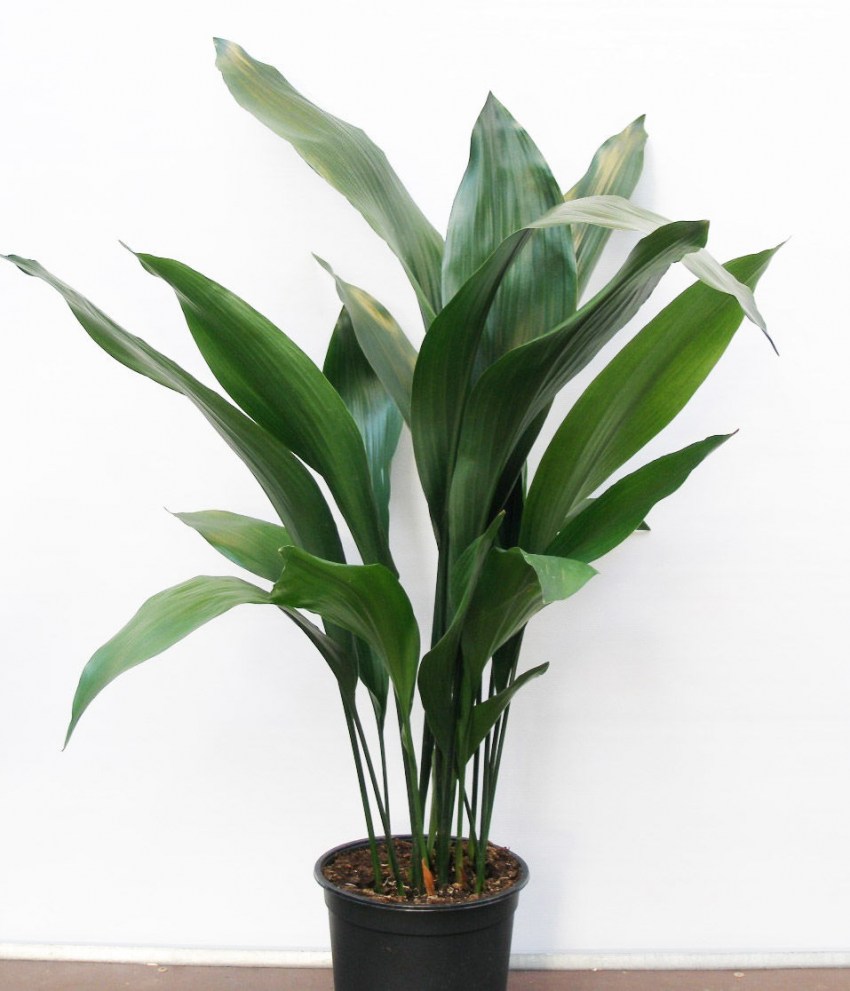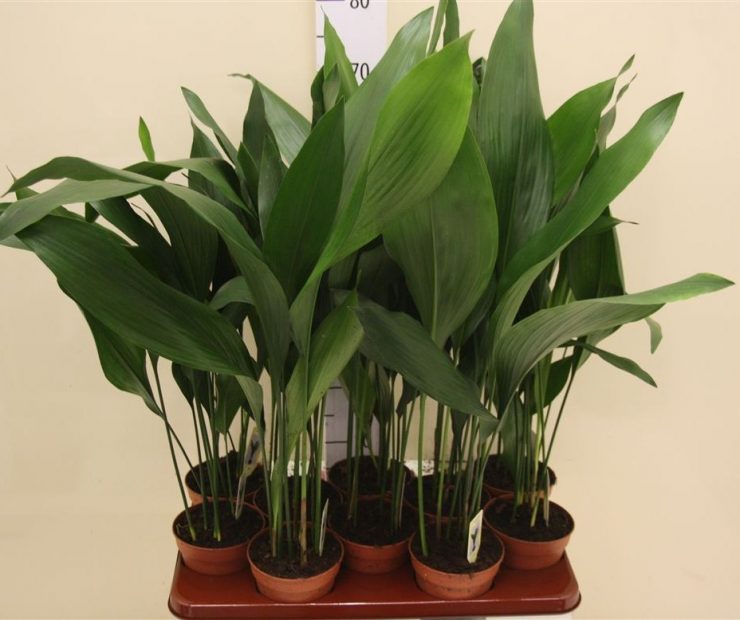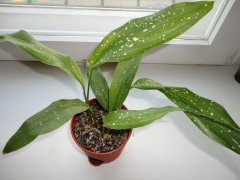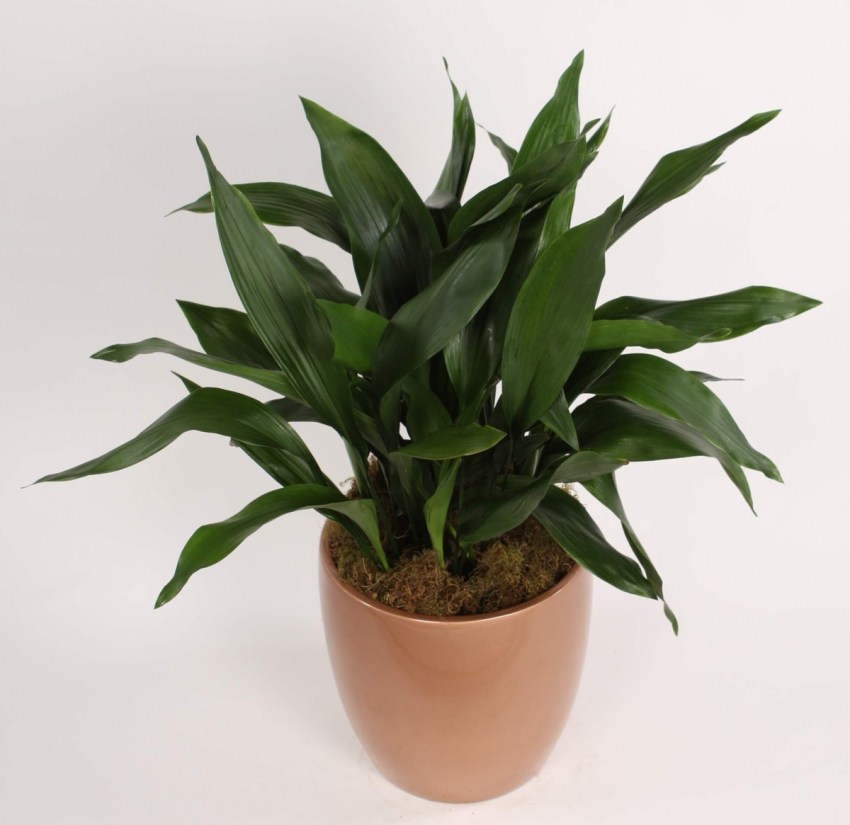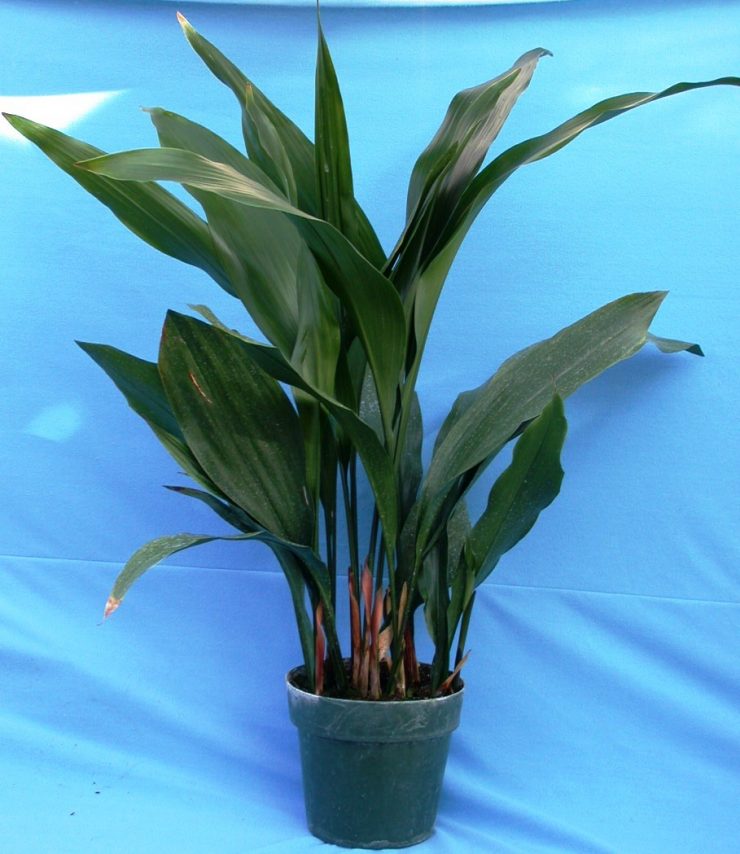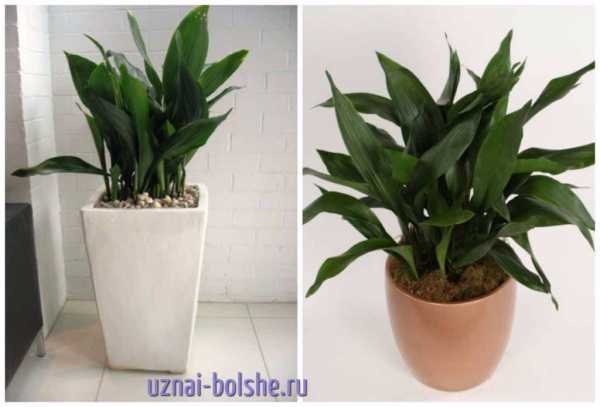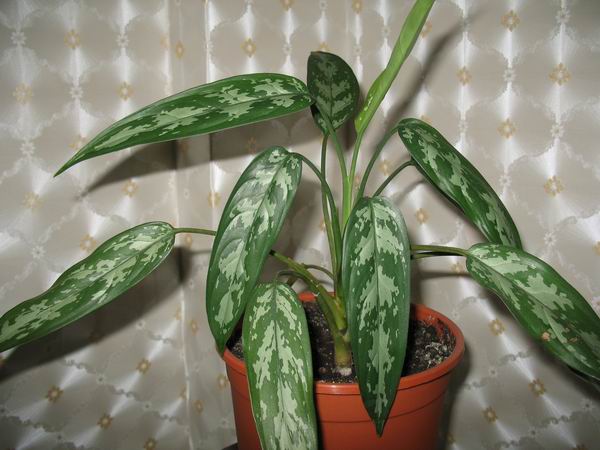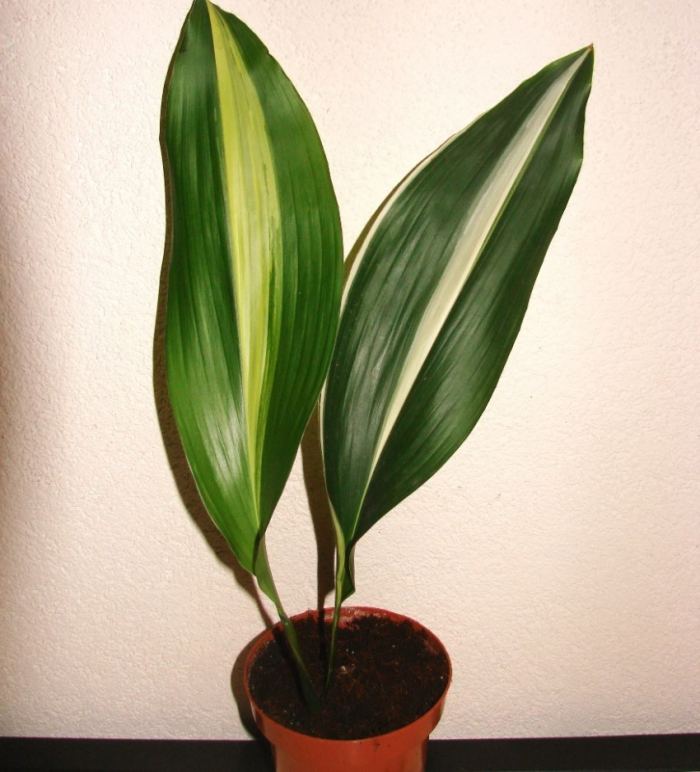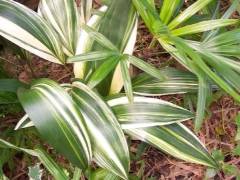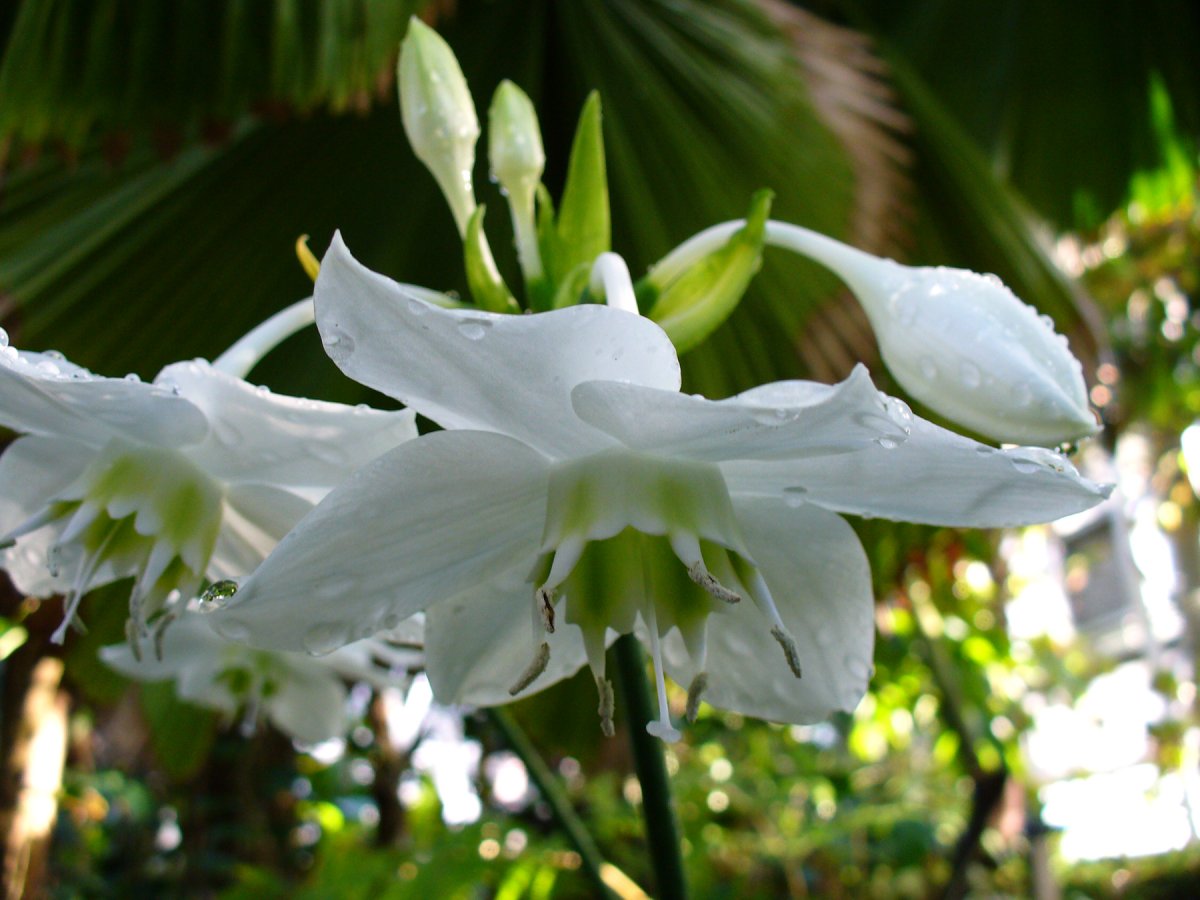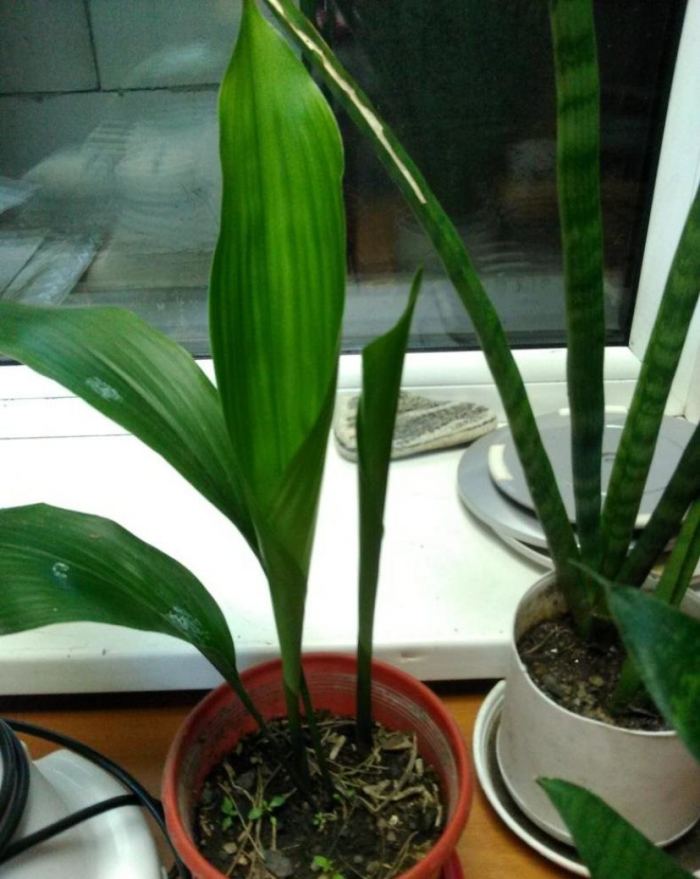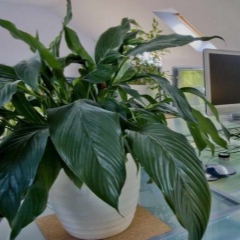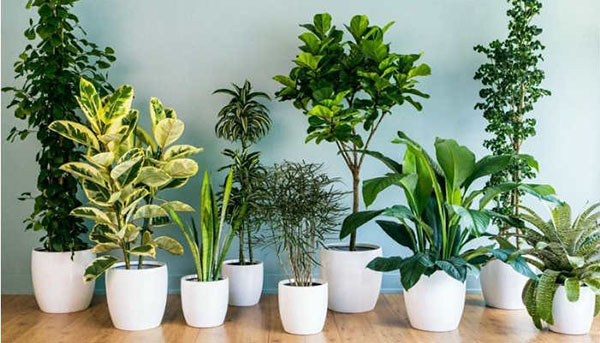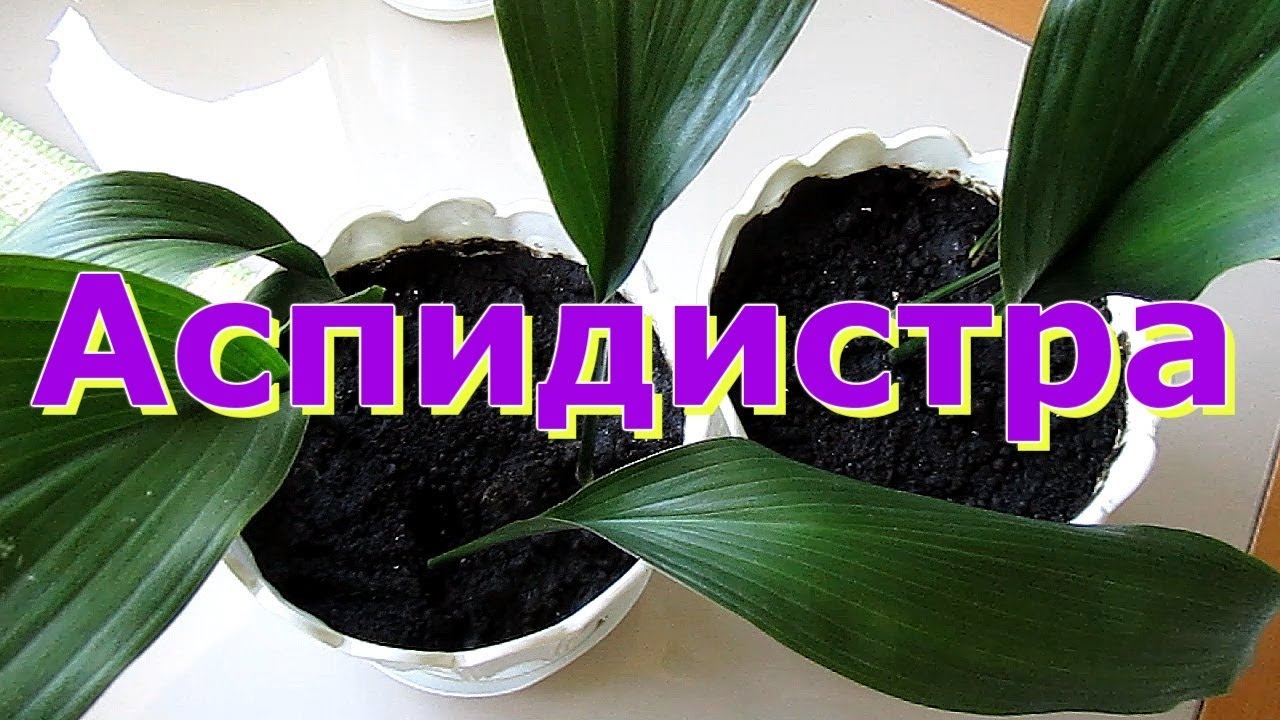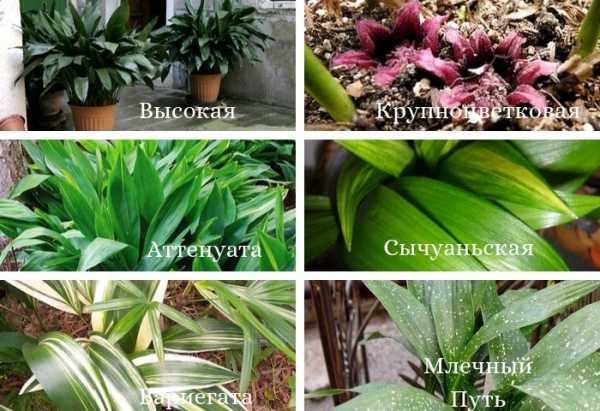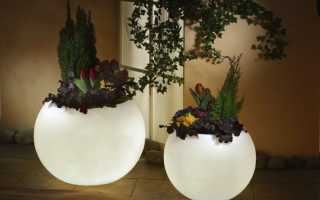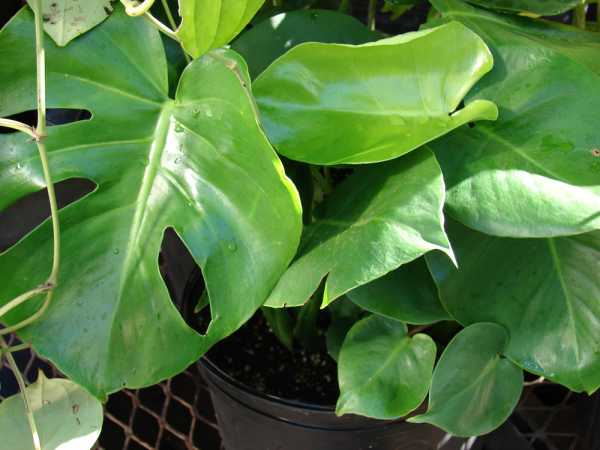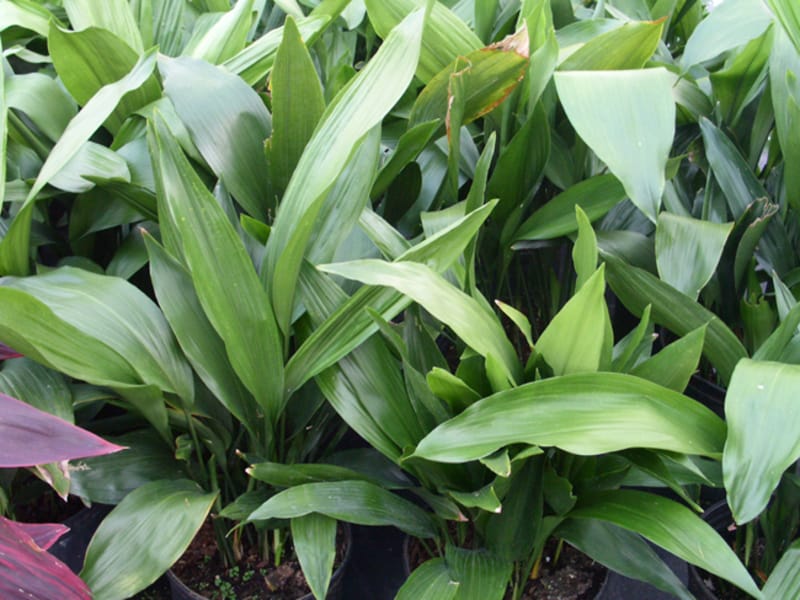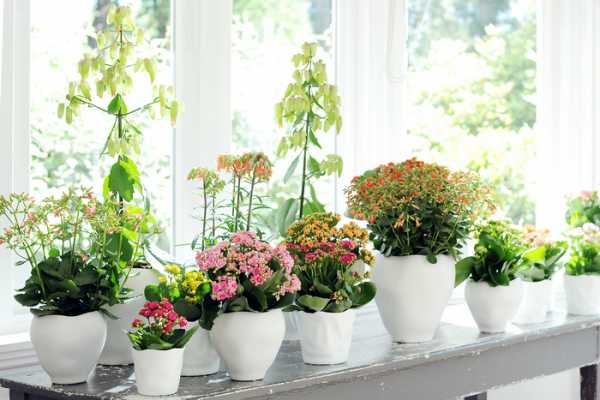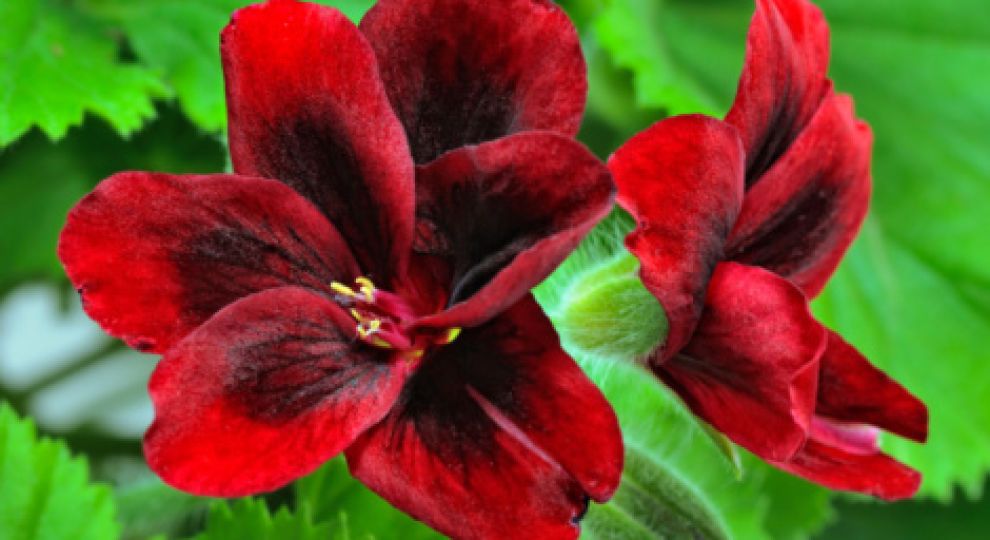Proper care for apidistra at home
If your windows face the north side, they are blocked from the sun by a high-rise building or a balcony on the upper floor, aspidistra will be an ideal plant that will create a green corner. It is unpretentious in maintenance and is better than others for the first experiments in creating a home garden.
On this topic:
BACK
FORWARD
1 of 2
Like any plant, apidistra has features of care. The requirements are reduced to the creation of conditions for existence, providing:
- external factors of content;
- the composition of the soil and the timing of its replacement;
- watering and fertilizing;
- pests and diseases.
The determining factor is the shade tolerance of aspidistra. The plant feels great in partial shade and in diffused lighting. If the leaf blade begins to fade, then the lighting should be slightly increased. There are variegated aspidistra, which, under diffused light, increase the contrast of the stripes, they become more elegant. Dots appearing on the leaves indicate sunburn.
In the shade of aspidistra in the summer, it lives well in the fresh air, in the country, on the balcony. In this case, a small cover should be created from the scalding rays of the sun. It is not affected by night and daytime temperature drops. However, the plant develops comfortably at an average of 22. In the heat, the leaves dry out, the roots do not have time to water them.
Winter maintenance of plants in cool conditions, about 10, gives an acceleration in the growth of young greenery in spring. But in home conditions it is difficult to create such conditions, however, 15 degrees can be provided. Accordingly, watering is reduced in winter, the plant is not fertilized and the humidity is not increased by spraying.
The flower does not require frequent moistening of the leaves, but it is grateful to the shower, wiping the leaves from dust. It must be remembered that aspidastra loves frequent moderate watering with settled soft water. Moisturizing a clod of earth should be 2-3 times a week in summer, in winter half as often.
On this topic:
BACK
FORWARD
1 of 2
As for fertilizers, the flower is almost an ascetic. Frequent feeding is harmful to him. For variegated breeds, overfeeding can cause the disc to turn green. On the other hand, the richness of greens also depends on adequate nutrition. How to fertilize aspidistra and how often are selected empirically, depending on the composition of the soil, the timing of the last transplant.
It is recommended to use liquid fertilizer "Uniflor", which is produced for growth, for green leaves, variegated species. The frequency of application is from 2 weeks to a month during the growing season. But if cracking of the leaves is suddenly noticed, this is overfeeding. Then stop fertilizing watering until the beauty of the leaves is restored.
An unpretentious plant does not require a special composition of the earth. For him, the soil that is prepared for seedlings of garden crops is enough:
- sod land - 2 parts;
- peat - 1 part;
- humus - 1 part;
- sand - 1 part; leaf land - 1 part.
As always, the addition of vermiculite and crushed charcoal is encouraged. Aspidistra will develop in regular garden soil or purchased universal soil. plant transplant is carried out every 3 years. But the root grows quickly, so each transplant requires a 2-fold increase in the volume of land. Old plants are not transplanted, but they change the ground from above. The root system does not like shocks - this is the peculiarity of the aspidistra. The optimal method of transplanting is transshipment without destroying the clod of earth. The pot should allow the leaves to grow in breadth. In this case, a sufficient drainage layer is necessary for the plant.
Reproduction of aspidistra is carried out by dividing the bush during transplantation.In this case, it is necessary to perform the operation in the least traumatic way. If you pinch off a root with 4-5 leaves, then the main bush will take it painlessly.
Reproduction is carried out by dividing the leaf blade into fragments using a knife. Sections are dried. The resulting pieces are dipped into an airtight container with water. It can be a vessel with a wide mouth. In this case, complete tightness is achieved. The lid is poured with paraffin, covered with plasticine.
Roots should appear on the edges. Then the seedling is placed in the ground and covered with a glass jar on top. When the aspidistra takes root, young leaves will appear, which must be looked after as well as adult plants.
Flower transplant
The harsh aspidistra still has a slight weakness - the plant does not like transplanting. For many gardeners, this is not a minus, but rather a plus: no need to fiddle with pots and soil, it is enough to carefully change the top layer of the substrate. And a large transplant for aspidistra is arranged every 3-4 years, when the pot where the flower lives becomes small. An unpleasant procedure for the plant is carried out in the spring.
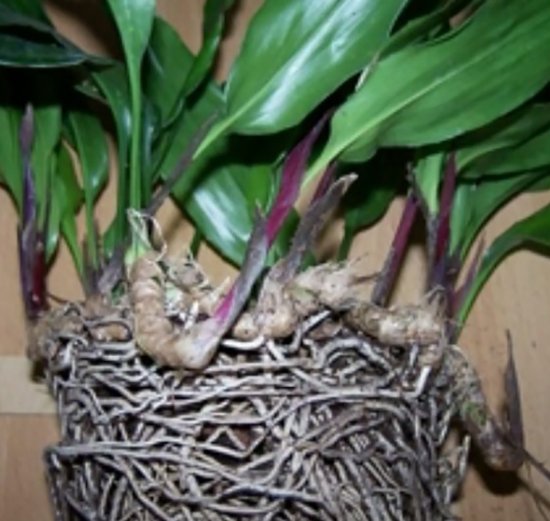
The root system of the aspidistra is very fragile
The “shoemaker's palm” does not make high demands on the soil. But drainage is needed worthy, from stagnation of moisture at the delicate roots, the flower can get sick. Soil options for aspidistra:
- ready-made soil for ficus or palm trees with the addition of vermiculite or compost;
- sand, leaf and humus land in one part, two parts of sod land;
- in equal proportions of sod and leafy soil, as well as sand, you can add compost.
The pot of the aspidistra needs an extensive one. For an adult plant, take a capacity twice the volume of the root system. Drainage holes are required.
Transplant process:
Take a suitable pot, place drainage on the bottom (pebbles, expanded clay, broken foam).
Spread the disinfected soil substrate on top
Do not tamp it tightly, it should keep airiness.
Remove the aspidistra carefully, being careful not to damage the roots, from the old pot.
Place the earthen plant ball into a new pot. Add soil gradually
Lightly tamp the substrate at the roots.
Do not deepen the plant, the rhizome of the aspidistra should be located at the surface of the soil so that new leaves can break through to the top.
Leave a few inches of soil up to the top of the pot. Thanks to this, it will then be more convenient to update the substrate.
After transplanting, water the plant with warm water, you can spray it.
Move the transplanted aspidistra to a shaded area.
Diseases and pests of aspidistra and control measures
The main pests of the plant: spider mites, aphids, scale insects, worms. When infected with spider mites, a silvery, very thin cobweb appears on the back of the leaves, the leaves turn brown and gradually dry out. It is necessary to regularly humidify the air and spray the plant with warm water. In case of severe infection, treat with actellik.
The first signs of infection appear as dark brown lesions on the trunk at or just below the soil level. These symptoms usually go unnoticed until the next stage, when yellowing and death of the leaves begins. The fungus produces white, fluffy mycelium on infected tissues and soil.
Prevention - use sterilized, well-drained soil. Avoid waterlogging of the soil. As a preventive measure, spray with a biological product against rot.
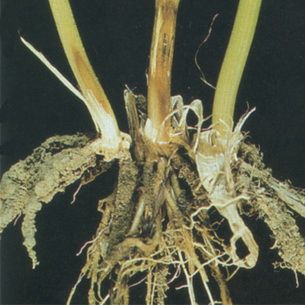
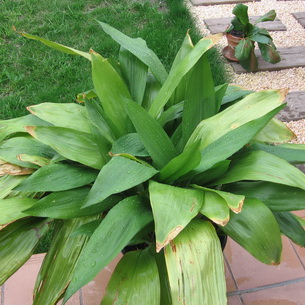
Root rot. The leaves begin to fade at the base of the petiole, the roots turn black.
Prevention - Use sterilized, well-drained soil. If the plant is sick, it must be destroyed.
Brown or brown spots appearing at the edges and tips of the leaves. The reason is sunburn.
Control measures: Place the plant in a shaded area.
The leaves of the plant turn yellow, the petals of the flowers turn green and the color changes.The reason is a viral disease.
Control measures: destroy the diseased plant.
Leaves turn yellow. Reason: excessive watering, stagnation of water in the sump, especially in the autumn-winter period, when the soil temperature decreases.
The leaves of the plant turn pale. The reason is the lack of light.
Role in air purification
Aspidistra is one of the most unpretentious indoor plants. These cute green bushes can grow in the most inappropriate places in terms of lighting - on the northern windows, on a closet in the back of the room, in public areas with weak artificial light.
This is due to the fact that in nature the plant lives in the dense forests of Southeast Asia - the lush crowns of trees always protect it from the sun.
Therefore, I recommend everyone to have this plant both in the kitchen and in the bedroom - caring for it does not require much time from you, and the benefits will be significant.
Aspidistra is good because it rarely turns yellow or loses color (only under conditions of sharp light). The plant has a high decorative value, it is very fond of room designers - aspidistra will make any room stylish, especially decorated in a modern style.
Aspidistra leaves are almost the same size, grow evenly, with equal small intervals. Because of this, the flower was popularly called "friendly family".
Invisible and unpretentious beauty
Aspidistra does not require any special soil: you can take regular garden soil or standard flower soil from the store and your plant will be pretty.
It is also convenient that the plant can be transplanted quite rarely, once every three years. The green mass is added slowly - 6-7 leaves per year, so the volume of the bush remains practically unchanged.
Moreover, the plant does not even like to be transplanted, especially "age" bushes. You can simply add soil from the top, that will be enough.
The flower is highly valued by the owners of apartments entering the north. There are very few domestic plants that can tolerate the poor illumination of northern windows, especially in the middle lane or even in the northern regions. Aspidistra grows there, and grows beautifully! She is more likely to fade on the southern windows, but the shaded areas seem to be especially for her.
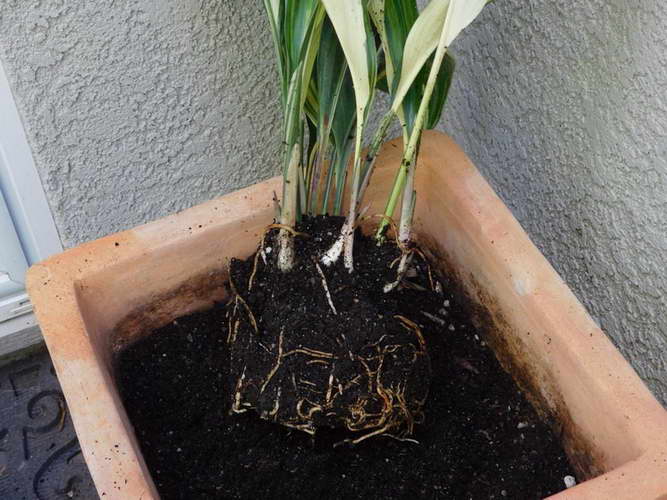
Aspidistra: the story of the discovery of the plant
The first plants, today classified as the Asparagus family, were discovered and described in 1822 by the botanist Gene Gohler. He also gave the name to the aspidistra, but according to the then prevailing ideas, the genus was attributed to the Lilia family, where it stayed until 2009.
The reason for being classified as a plant related to asparagus and lily of the valley was the fact that, unlike lilies, it did not have bulbs. It is surprising that scientists so late noticed such an obvious circumstance, but practically from the discovery and until the 80s of the last century, very little attention was paid to the aspidistra by botanists.
This circumstance can be judged only because the methods of pollination of the plant are still not clear, and the flowering itself has been extremely little studied. In addition, in the 70s, scientists described only 8-10 species, but over the next decade, about thirty more species were discovered in China. By 2008, scientists already had 93 independent species of the aspidistra plant at their disposal. And today they are already talking about 101 species, and not all discoveries have been made, because it turned out that the plants of this promising genus have a very extensive range.
Growing tips
Aspidistra is an unpretentious plant that is afraid of direct sunlight. Home care will not cause difficulties even for inexperienced flower growers. The flowerpot can be placed in any darkened place. A tall plant does not require special weaving devices.Varieties with variegated foliage need more light. In the absence of natural sunlight, the plant can grow and develop, receiving only artificial light.
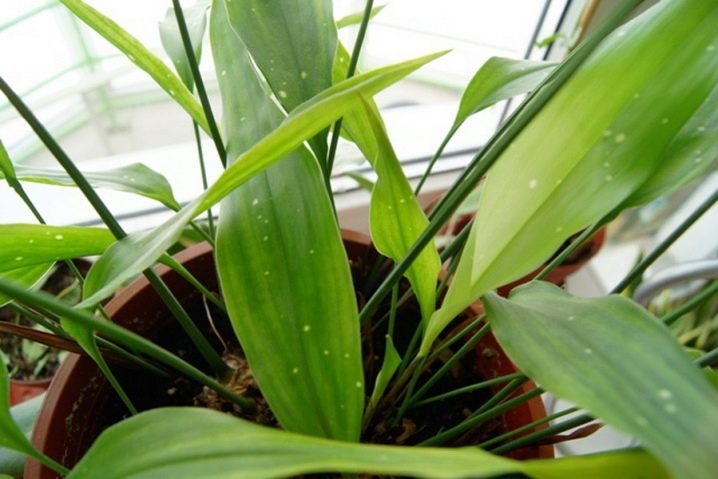
The optimal temperature regime in the summer is in the range from +20 to +25 degrees. In winter, the plant feels comfortable at +16 degrees. The flower is not picky about air humidity, but it needs regular dust removal from the leaves with a wet sponge. The plant prefers regular and moderate watering, which should be carried out after the top soil layer has dried. For irrigation, use settled water at room temperature. In winter, at an air temperature of no more than +18 degrees, it is enough to moisten the soil once every 2 weeks.

It is strictly forbidden to use non-settled water for irrigation, which contains a large amount of mineral elements and salts. Together with water, the tuber transfers to the leaves and dissolved salts, which, when evaporated, are deposited on the leaf plate and provoke the development of burns. With prolonged use of poor quality water, the flower can not only get sick, but also die.
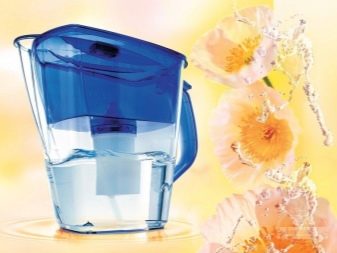

Aspidistra responds positively to the timely application of mineral and organic fertilizers. To carry out top dressing, it is necessary to purchase complex fertilizers for deciduous ornamental plants in specialized stores. Varieties with bright spots do not need feeding, which can cause the spots to disappear. Pruning of aspidistra is carried out only in sanitary measures, when dry and damaged leaf plates appear among healthy and bright leaves. You need to cut off the diseased leaf at its very base.

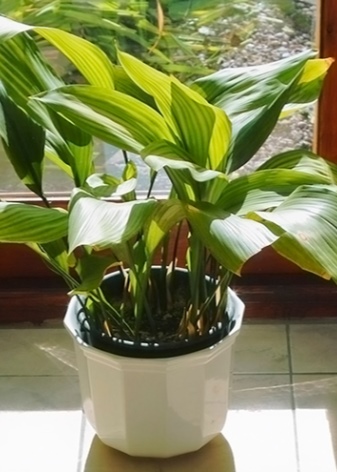
When growing aspidistra, a number of the following problems can arise:
- dark spots on the leaf plate - the consequences of sunburn; treatment - placing a flower pot away from direct sunlight;
- decay of the root system - the consequences of prolonged waterlogging of the soil; treatment - normalization of watering frequency;
- yellowing of the leaf plate is a sign of aging or damage to the flower by dangerous insects; biologists identify several of the most common pests - spider mites and scale insects; treatment - treatment of the plant with special chemicals;
- wilting of foliage - non-compliance with the irrigation regime; you can restore the plant with the help of moderate and regular soil moisture;
- drying of leaves - the presence of a low level of humidity in the room; treatment - increasing the number of sprays;
- a change in color is a sign of excessive fertilization and low light levels;
- the absence of young shoots is a sign of a lack of nitrogenous elements; treatment - fertilizing the plant with a urea solution.
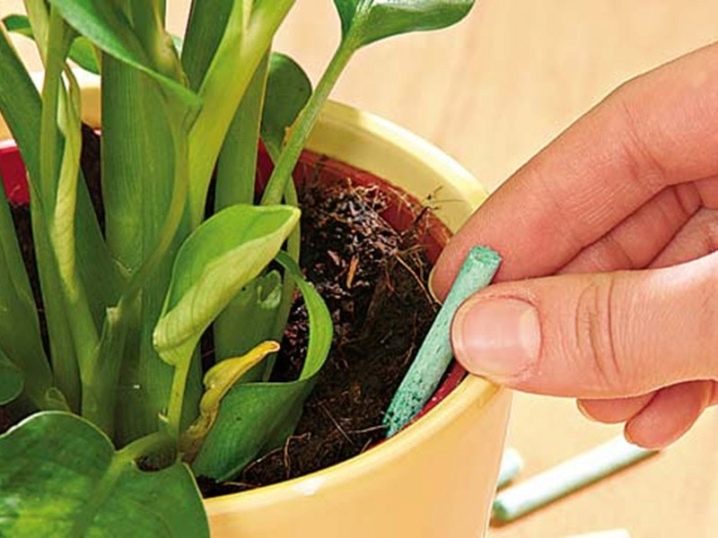
Types of aspidistra and their flowering period
Now read the description of the aspidistra of various types.
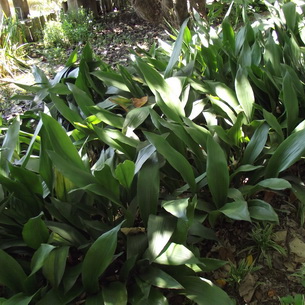
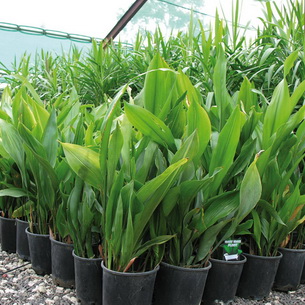
Aspidistra attenuate. The appearance of Aspidistra attenuata from the mountain forests of Taiwan is very similar to the description of Aspidistra broadleaf. But it was opened a hundred years later, in 1912.
The plant has a creeping, round in cross-section rhizome with a diameter of about 1 cm. Growing up on loose, drained forest soil, this variety of aspidistra forms dense clumps. Dark leaves may be decorated with small light spots. The length of the petioles is 30–40 cm, and the inverse lanceolate leaf blade can be up to half a meter long. The width of the leaf is much smaller and is about 8 cm.
The plant forms flowers up to 5 cm in diameter, with 3-5 bracts. The bell-shaped corolla is purple in color, while the petals can be almost white or greenish. Inside the flower there are 7 to 8 stamens and a pistil up to 5 mm in diameter. The flowering of cultivated aspidistra, especially variegated, is much more interesting and brighter.
The flowering period of this species begins in June, fruits appear a little later.
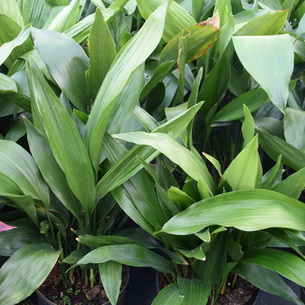
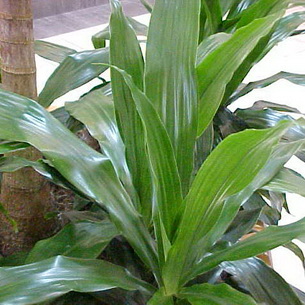
Aspidistra grandiflorum
This species of aspidistra was recently discovered in Vietnam, and the plant immediately attracted the attention of lovers of tropical crops. The reason is in single, up to 80 cm long, obovate leaves with contrasting spots on the plate, as well as in the amazing flowering of aspidistra
In the middle of summer, two or three flower buds appear on the roots of the plant, which turn into flowers with a diameter of 2 to 4 cm. Purple corollas are held on creeping stalks about 5 centimeters long. Each petal has a white, elongated appendage with dark purple edges.
Inside a flower resembling a tropical spider, there are 11 or 12 stamens up to 3 mm long. The disc-shaped pistil is about 3 mm long and up to 5 mm in diameter. In the wild, flowers appear above ground level in July. At home, flowering is not so regular and largely depends on the care of aspidistra.
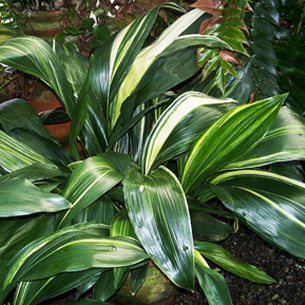
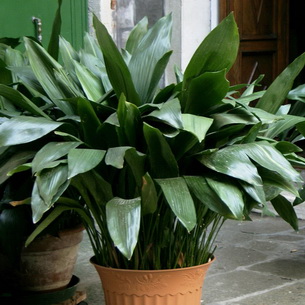
Sichuan aspidistra. The homeland of this species of aspidistra is the bamboo forests of China, where at a level of 500-1100 meters above sea level, the plant forms densely overgrown glades.
She has a powerful creeping rhizome with a diameter of up to 12 mm and single erect leaves up to 70 centimeters high. The leaf plate with arched venation is distinguished by a dense green or spotted color and grows up to 35 centimeters. The width of the lanceolate or elliptical-lanceolate leaf is from 4 to 8 cm.The petiole, depending on the variety, can reach a length of 10 to 40 cm.
The flowering of the Chinese species occurs from January to March. The flowers are attached to the root with a 5 to 50 mm long stalk. Inside the bell-shaped corolla with six petals there are 6–8 stamens and a large columnar pistil up to 12 mm in diameter.
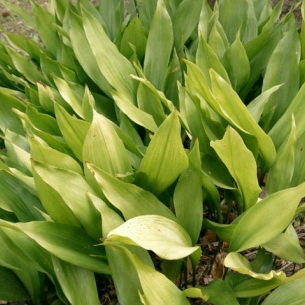
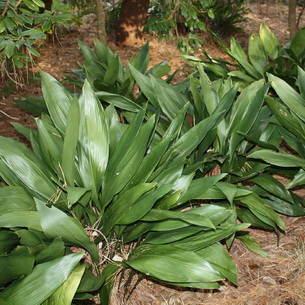
Aspidistra oblantsefolia. Another species of aspidistra from China also has small flowers, but this is not the only feature of the plant. It has narrow obverse lanceolate leaves, the width of which is only 2.5–3 cm. The leaves are thin, only 5 mm in diameter, scaly rhizomes and single ovoid or elliptical shapes. A 20 cm long leaf plate is held on a long petiole that grows up to 40 cm in length. The leaf itself is not as large as in other species. But on a wide plate, yellowish, chaotically scattered spots are clearly visible, often found on plants of this native of China.
Pests
Insects do not really like the aspidistra, so they rarely attack it. But there are pests that can still attack the flower. These include two types of insects.
Red spider mite
In the aspidistra, the leaf blades begin to turn brown and subsequently dry out, the inner side is covered with a thin silvery network of cobwebs.
How to deal: red spider mites do not like moisture, so it is worth regularly spraying the plant, covering it with plastic, to keep moisture. In the absence of a result or with extensive damage, the flower can be treated with insecticides: Temik, Aktellik, Karbofos, Aldikarb.
Shields
Scabies: fern and aspidistra are small sucking parasites that settle on the inner side of the leaf and suck out the sap of the plant. The leaves are covered with a sticky bloom, which loves a sooty fungus (causes black spots), turn yellow and fall off.
How to fight: wash the platinum sheets with soapy water, pick up the parasites with your hands. Treat the plant with insecticides of a broad spectrum of action, such as Fitoverma, Permethrin, Actellik, Fufanon, Arrivo.
Caring for an aspedistra at home is quite simple. But remember that even the most unpretentious plant requires attention and care!
And for the most curious, we suggest that you familiarize yourself with a completely amateur video about what an aspidistra looks like
Description
A representative of the asparagus family, an ornamental leafy plant aspidistra, grows naturally in East Asia.This herbaceous perennial looks beautiful and unusual - it has long rich green leaf plates with light veins that form a lush crown. In height, an indoor flower can reach 80 cm, and in diameter about 15 cm or more.
Aspidistra has no stems, the growth rate is average - it gives 2-3 leaf plates per year. The life span of a plant is up to 10, maximum 15 years, every couple of years it must be transplanted. Flowering is short, with apartment growing, flower arrows rarely release, if the buds are tied, then only in the summer season. To get a flower as with a photo, aspidistra needs home care that complies with the rules, but in general the plant is not capricious.
Aspidistra transplant
The plant is hard going through such an intervention, therefore, experts do not advise transplanting the aspidistra more often than once every 2-3 years. If the aspidistra in the pot has grown very much, then a more voluminous container is selected for it and transshipment is carried out without clearing the earthen lump. A layer of expanded clay is poured onto the bottom, then a little soil is added and the plant is placed, filling the voids with soil mixture. The top layer should be lightly compacted so that the upper parts of the root necks remain on the surface. The final stage is watering the plant.
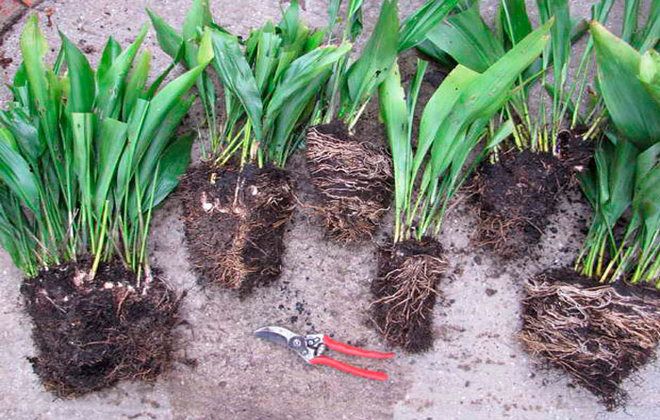
Soil for aspidistra
You can buy a universal soil mixture for a flower - its varieties are widely represented in specialized stores. In residents of the southern regions, aspidistra grows right in the garden, so we can conclude that it is unpretentious to the quality of the land. However, everyone can prepare the soil with their own hands by combining turf, manure humus, river sand and leafy soil in a ratio of 2: 2: 1: 2. The aspidistra plant feels great in a mixture of such components and responds with good growth and an abundance of green foliage.
Growing aspidistra
Aspidistra can grow in the very depths of the room, far from the lighting that it could get from near the window. She tolerates shading very well, but nevertheless, with insufficient lighting, it can fall into a state of dormancy for a long time. And for its good rapid growth and abundant flowering, bright light is needed, without direct sunlight. If you take good care of Aspidistra, it will bloom regularly and every year 5-6 new leaves will increase.
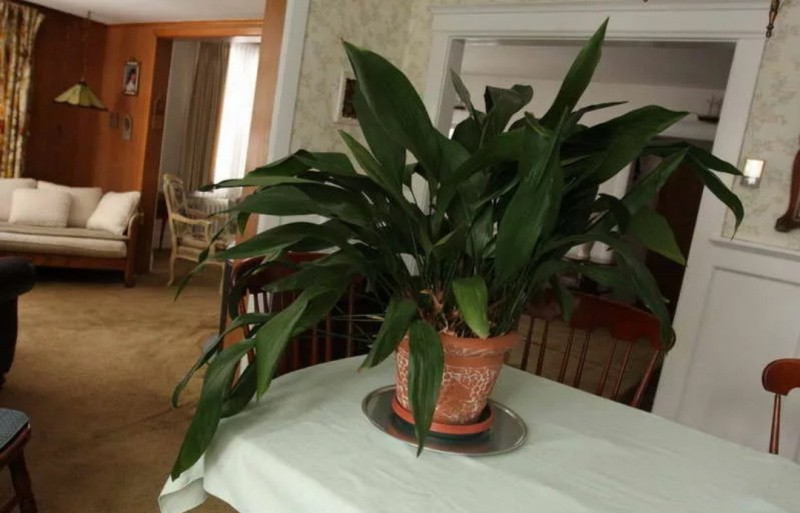
If the leaves are variegated, then the flower needs more light; if there is insufficient light, they will just turn dark green. Direct sunlight should be avoided. Watering only as the substrate dries up. Any land containing humus and sod soil is suitable.
The plant has such a wonderful property as the accumulation of dust on the leaves, cleaning the room in which it is located. For Aspidistra, we tolerate a lack or excess of moisture, but it does not tolerate waterlogging of the soil. The appearance of gray spots on the leaves is a sure sign that the flower is flooded.
Aspidistra tolerates a fairly wide temperature range within 5-35 degrees. When kept dry, it is advisable to spray it at least occasionally. After all, too dry air can also cause browning of the leaves. The dormant period begins in winter, since the daylight hours are reduced, and, as you know, when rearranged in a dark place, this plant stops growing.
Aspidistra is a bush of dark green or variegated oblong leaves. Indoors, they can grow up to a meter in length, on average about half a meter. Aspidistra grows very, very slowly. Sometimes you even get the impression that it is not growing at all. If you want to speed up the growth of aspidistra, feed it with nitrogenous fertilizers and put it closer to the light. When new leaves appear, but more often only one, the aspidistra can be put in its original place. Due to the large surface of the leaves, dust can accumulate on them, therefore, the leaves must be wiped with a damp cloth in time to facilitate breathing of the flower.
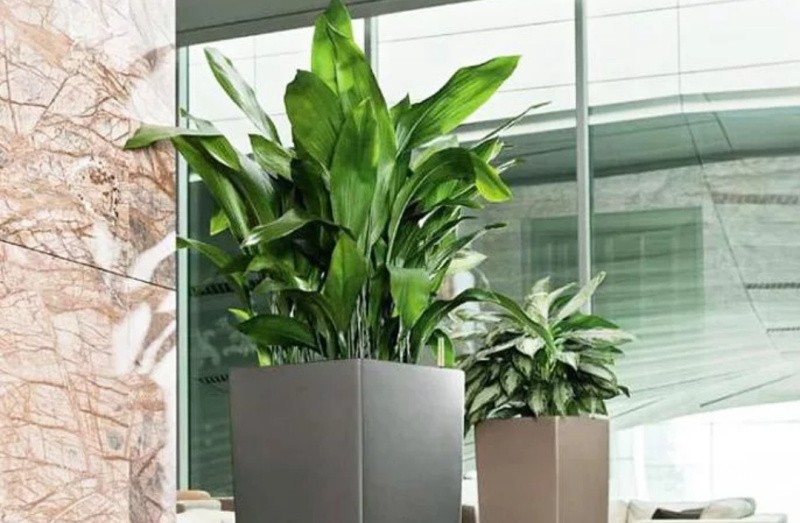
The flowers of the aspidistra are inconspicuous, dirty purple in color. They look like water lilies. They are odorless. Flowers are located on a creeping rhizome at the very surface of the earth. Flowering ”begins in early spring and lasts a couple of months. Glossy aspidistra leaves are often used in the composition of bouquets, due to their decorative effect and the ability to not fade for a long time. Aspidistra can be grown in bedrooms, in children's rooms as it is harmless. Moreover, substances secreted from aspidistra are used in medicine.
Aspidistra transplant
Aspidists are not very fond of interventions in their root system, therefore, transplantation is carried out only when necessary - no more than once every 3 years. For planting, a universal nutrient substrate for indoor plants is used, mixed with perlite and vermiculite. When planting a plant, try not to deepen the underground rhizome - the root necks of the shoots and growth points must be located only above the surface of the substrate.
For adult aspidistra, you can simply add fresh soil or replace the top layer of the soil substrate. When transplanting, you can propagate the aspidistra by dividing the bush. New seedlings take root well. The pot for planting must be doubled as the root system of Aspidistra.
Types of aspidistra with photos and names
In indoor floriculture, few species of aspidistra are grown. These varieties differ in the height and width of the leaf plates, as well as their color. Some varieties of aspidistra are relatively low - up to 40-50 cm, while others are capable of reaching 80 cm in length. The inflorescences of a houseplant, regardless of the variety, are relatively small, on a long peduncle (with the exception of some varieties). The care is the same for all varieties and types.
High

This type of home flower got its name due to the rather large parameters of the bush. In the natural environment, the size of the high aspidistra reaches 80 cm, and when grown indoors, the plant stretches to 60-70 cm. The length of the sheets is 30-40 cm, and the width is 10-15 cm. The shape of the leaf plate is pointed, elongated. The foliage is glossy, deep green. For a year, the plant is gaining up to 5 sheets. At home, it almost does not bloom, if the inflorescences are formed, then they are small - up to 3 cm, purple-scarlet.
Bloom

The leaf plates are glossy, like the tall aspidistra, but dark green in color. The foliage resembles a lily of the valley in shape, but is larger, reaching 50 cm in length and 15 cm in width. Inflorescences of aspidistra bloom are formed directly at the roots, in the bud there are 8 petals. The color of the inflorescences is yellow or crimson. At home, aspidistra bloom may never release buds.
Variegated

The height of the variegated aspidistra bush reaches 50 cm. The plant is capable of growing strongly, so in a few years, with proper care, there will be a lush bush. Leaf plates of a dark, saturated green color, against this background there are cream vertical stripes
This variety is somewhat more demanding to care for, compared to other varieties - it is important for it to fully comply with the rules for growing aspidistra as an indoor flower
On a note! When agricultural practices are violated, cream streaks can disappear. This is often the result of overfilling or over-feeding or over-feeding.
Large-flowered

A fairly new variety of aspidistra. The peculiarity of this species is large inflorescences and long oval-shaped leaf plates. Also, the large-flowered aspidistra has another difference - it forms a lush shrub over time. When grown on a windowsill, it rarely blooms, inflorescences with a diameter of 5 cm, located at the roots. The petals are dark purple in color, resembling spider paws in shape.
Milky Way

The height of the bush ranges from 40-60 cm. When the growth of leaf plates is not limited, the bush grows dense and lush. The plant calmly tolerates periods of drought and short-term drops in temperature.The leaf blades are green, with a large number of dotted milky white markings over the main tone. A slow-growing variety, the flowering period of which is possible in indoor conditions, but falls at the end of winter or early spring. Small flowers with pointed purple petals.
Attenuata
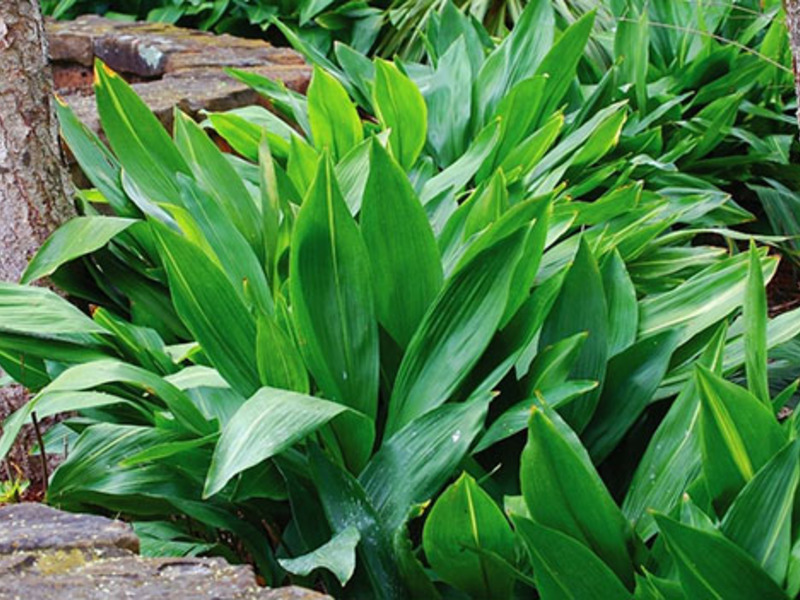
An evergreen plant with leaf blades, which have long petioles, reaching 30 cm.The leaf itself can grow up to 50 cm in height. The main tone of the foliage is green, but there are small whitish blotches. A hardy variety that tolerates short-term drops in temperature. It begins to bloom in early summer, the inflorescences are purple, up to 3 cm in diameter.
Oblantsefolia

Under natural conditions, aspidistra oblantsefolia grows at an altitude of 700 m in the bamboo forests of China. A rather lush bush with oval-shaped leaf plates. The length of the foliage reaches 30 cm, the width is up to 8 cm. The main color of the leaf plates is rich green, but against this background there are longitudinal curved whitish stripes. Flowering period in spring, inflorescences are colored deep purple.
Sichuan

The leaf blades of the Sichuan aspidistra are rather narrow, their width does not exceed 3 cm. The foliage is uniform, intense green, some varieties of this variety have small yellowish blotches. The full height of the plant reaches 60 cm. The inflorescences, when they are formed, are star-shaped, small in size, the color of the petals is rich scarlet. Unlike some other varieties, it blooms in early spring.
Guanjou

The difference between the variety and others is small leaf plates, the length of which does not exceed 20 cm.But, the leaves have elongated petioles that reach 40 cm.The color of the foliage of the Guanjou aspidistra is green, but against this background there are small yellowish blotches. Inflorescences are formed in May, the flowers are large enough, painted in purple or lilac.
Reference! The flowers of the Guanzhou aspidistra are similar in shape to the large-flowered buds.
Possible diseases
Various diseases are found in aspidistra room. Some of them can be prevented or cured instantly by simply changing the lighting or watering conditions. Others take a long time and painstakingly to heal.
Most often, the leaf in aspidistra is affected: spots appear, the foliage turns yellow, withers, withers and falls off.

Leaf diseases
What problems happen:
- Brown spots on foliage indicate sunburn. It is worth immediately transferring the flower to the shade.
- Yellowing, wilting of foliage. The soil is too moist, the roots are rotting. Transplant the flower and stop watering abundantly.
- Leaf pallor, color is lost. The place is too dark. Transfer to where the light is diffused.
- The foliage has become brown, on it a cobweb - a spider mite disease. Treat the crown with "Aktellik", humidify the air by spraying.
- The foliage falls off, turns yellow, you can see pests on it - these are scale insects. Collect the pests by hand, disinfect the affected areas with soapy water. After processing "Karbofos" or "" Fufanon ".
- When infected with an infection, chlorosis, the foliage rapidly turns yellow, and its shade changes. It is impossible to treat such a disease - the plant should be destroyed in order to avoid contamination of other domestic crops.
The oldest plant in the world is called "cast iron" for a reason. With its unpretentiousness and lack of capriciousness in care, it can hardly be compared with any culture.

